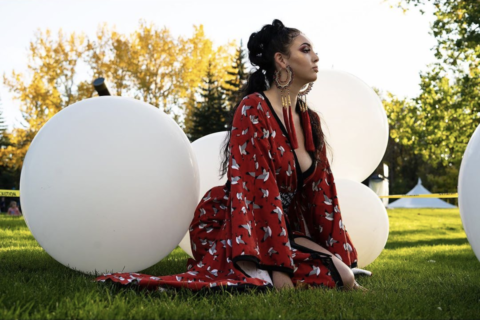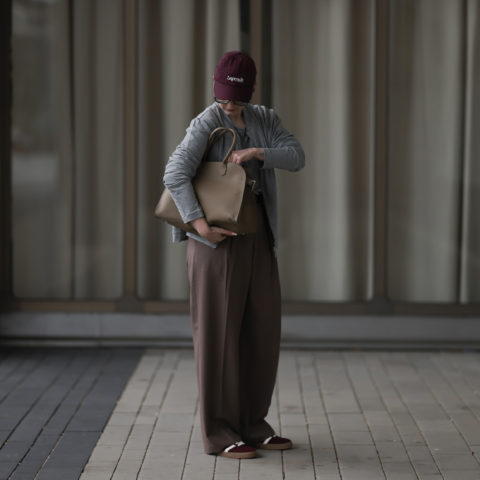Meet the Multi-Discipline Makers Behind Calgary-based Brand Indi City
"It’s about offering designs that are representative of things that are important to Indigenous people, and sharing that in an authentic way."
“My Blood Memory is Couture.” That’s the ethos behind the accessory label Indi City, helmed by Angel Aubichon and Alex Manitopyes. The brand produces an array of bold jewellery including earrings and bolo ties inspired by the duo’s Indigeneity; and the phrase is a nod to the painstaking level of craft involved in the beadwork and embroidery that Indigenous communities have made for generations. “It’s something that my great-grandmother did until she was like, 96-years-old and blind,” says Aubichon of beadwork.
Aubichon’s beading skills are self-taught, and a growing confidence in her artistry lead to the launch of a blog a few years ago–but she felt it ultimately wasn’t the right path towards a future in fashion. “I wanted to be a fashion designer since I was a little girl,” Aubichon says. “And I wanted to create a brand where Indigenous representation was at the forefront. A decade ago, there was a lot of cultural appropriation going on, and I think a lot of that had to do with the fact that there wasn’t authentic representation from Indigenous designers.”
For Manitopyes, developing Indi City as a brand has provided an entrepreneurial experience that combines a range of interests, from photography to graphic design, that were nurtured during her time as a student at the Southern Alberta Institute of Technology. “I’m a two-spirit Indigenous woman and I face a lot of oppression in a lot of work environments, and I’m also an artist,” she says. “I wanted to create a job where I could live my potential and do what I really want to do.”
The pieces Indi City offers create a connection between traditional techniques and technology, with the designs Aubichon and Manitopyes devise ultimately expressed in a mix of acrylic and beadwork. One of the brand’s early breakout moments came during Calgary’s Make Fashion event in 2017, where Aubichon debuted a piece of wearable tech–called “The Matriarch Speaks”–for its gala runway show; it was crafted “in commemoration of the matriarchal roles in Indigenous culture,” Aubichon says.
Having access to Make Fashion’s tech-forward resources, including a laser cutting machine, has been a boon to the brand as it facilitates the production of a larger selection of pieces for Indi City to sell. “Slow fashion is great, but it’s a hard way to sustain a business and family,” says Aubichon of the intense amount of time and effort needed to create beaded pieces. “We really needed to come up with a product that we could create and collaborate on that allowed us to have volume to sell on a website.” Being involved with Make Fashion has also allowed the partners to truly take a hands-on approach in their work. “We’re one hundred per cent DIY,” Manitopyes says. “We do it all.”
Laser-cut wares by Indi City have a variety of inspirations, including geometric-style designs that are conceived by Manitopyes; Aubichon typically takes a more hand-drawn approach. “I dream a lot,” she says of her creative process. “The things that I see and what I move through in my dream space–that’s where a lot of my design and my colour palettes come from.”
Some Indi City pieces have also been heavily inspired by the work of Aubichon’s grandmother. “My late Kookum had a body of [bead] work that she’d been making for years,” she says. “My great-aunt had them, and when she noticed that Indi City as a brand was really starting to pick up, she sent [the pieces] to me. It’s kind of been the catalyst for coming up with designs for the acrylics.”
For example, Indi City’s “Medicine Flower” earrings, which feature a cascade of single or multi-hued floral elements, are informed by the beaded heirloom pieces Aubichon was given. “Each of the flowers are representative of the different flowers that grow in the region where my Kookum was from, the Boreal Forest in the prairies,” she says. “Everything holds some medicinal property. It’s part of my life’s journey to find and understand all of the medicine florals,” she adds.
Another goal the pair share is in building the profile of Indigenous designers, hoping that in the future they can foster connections between communities and fashion brands from around the world. “Indi City is about building a global brand and creating a source that people can use to find Indigenous designs,” Aubichon notes. “Going forward, we’d like to bring on more designers and create a community where a brand like Valentino can come to us and tell us what kind of artist they’re looking for, and we’d be able to link them up with an Indigenous creator to collaborate with.”
Such a resource would be welcomed in the expanding landscape of BIPOC makers gaining much-deserved visibility in creative spaces, with Manitopyes pointing out the exciting potential within design to inspire current and future generations. “Growing up, a lot of the Indigenous things that we would see were in gift shops, like dream catchers and wolves on t-shirts,” she notes. “That didn’t resonate with us. We were like, what is this?” She says that they’re energized by seeing what peers are doing, including Justin Louis of the streetwear-focused brand Section 35. “The way he will take something political or iconic and Indigenize it is super cool,” says Manitopyes.
The creatives are also motivated by the potential for fashion to unite BIPOC and non-BIPOC communities through a collective connection to things including the natural icons, like strawberries, that Indi City uses in its designs. And, as Aubichon notes, it’s also a forum in which to explore more challenging concepts and topics. “Fashion has become a place where politics and design and creating dialogues with the rest of the community can happen–it’s such an easy way to bridge those gaps in a way that feels good.”
On that note, the duo highlight their brand’s name as being a nod to what kind of future could be forged as Indigenous creatives reclaim their practices and icons, and take a rightful place in the global fashion world. Aubichon sums it up with this metaphor: “We’re creating a city where we can walk side-by-side, and have true equal footing.”








